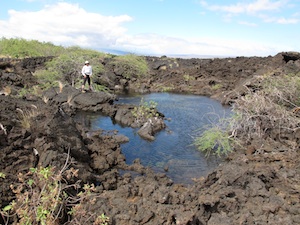Editor's note: Through its George Melendez Wright Climate Change Interns and Fellows program, the National Park Service enables university students to visit national parks to investigate issues related to climate change. Here are two of the studies being investigated by students. Thanks to the Park Service's Climate Change Response Program for making the profiles available.
Natural Resource Education in a Cultural Park
During her internship at Manassas National Battlefield Park, Bridgette Rivers worked to develop natural resource education in a park that traditionally focused education around the historical and cultural aspects of the area. She worked with Natural Resource Program Manager Bryan Gorsira to develop interpretive programs that could be run with minimal park support well after her internship ended.
One such program was a free cell phone tour, launched September 29, which allows visitors to dial into 14 different stops along the Stone Bridge Loop trail.

Thanks to Ms. Rivers, visitors to Manassas National Battlefield Park will have additional interpretative materials. NPS photo.
Each stop gives the listener natural resource information related to climate change and tailored to their location, and there are separate tours for children and adults in English and Spanish.
Another project Ms. Rivers is continuing to work on is a Junior Ranger booklet specifically focused on environmental education. Along with other parks in the District of Columbia area, Bridgette is working with the Blue Ridge Parkway Foundation’s Kids in Parks program to put in a kidfriendly Track Trail at Manassas, due to launch this winter.
In addition, website enhancement and partnering with local community members rounded out the projects she completed at Manassas.
Bridgette is a second year geography master’s student at Virginia Tech and aims to continue working with the NPS in the future.
Surveying Pools on the Big Island of Hawaii
Lisa Marrack spent the summer hiking through lava fields on the arid west coast of the Big Island of Hawaii surveying biotic and abiotic features at 195 brackish anchialine pools, some of which have never been mapped before.

Ms. Marrack spent the summer mapping and studying anchialine ponds at national parks on the Big Island of Hawaii. NPS photo.
This doubles the number of pools previously surveyed by the NPS. These groundwater fed pools stretch throughout the 175-mile Ala Kahakai National Historic Trail (ALKA) coastal corridor which includes Hawaii Volcanoes, Kaloko-Honokōhau, and Pu`uhonua O Hōnaunau.
Anchialine pools support endemic invertebrate communities, are important Hawaiian cultural resources, and face multiple threats (ie. sea level rise, introduced species, land-use practices). Ms. Marrack is using the field data along with spatial modeling techniques to predict: 1) resources that will be lost due to inundation; 2) resources that will be threatened by invasive fish dispersal as sea levels rise; and 3) future locations of high quality habitat.
Her ultimate goal is to share the results with private and public land managers along the ALKA corridor to target conservation actions and planning so this unique ecosystem will persist as sea levels rise.

 Support Essential Coverage of Essential Places
Support Essential Coverage of Essential Places






